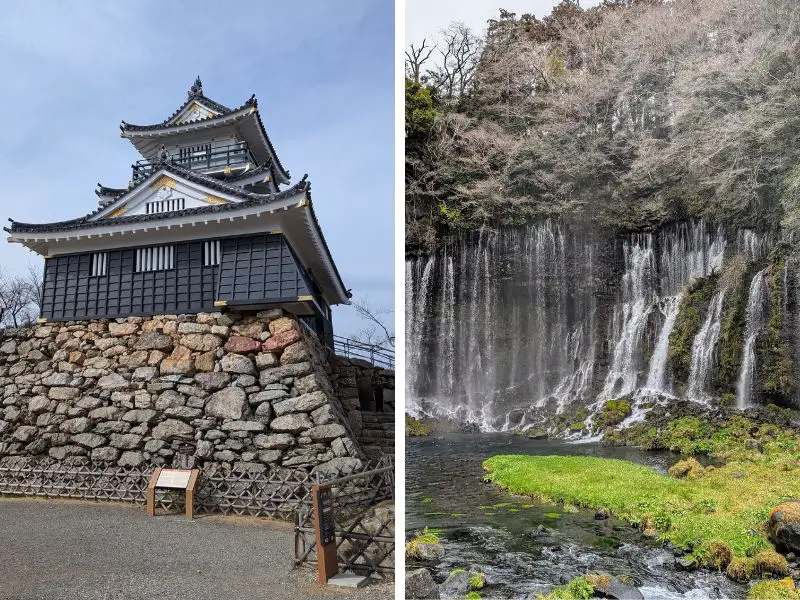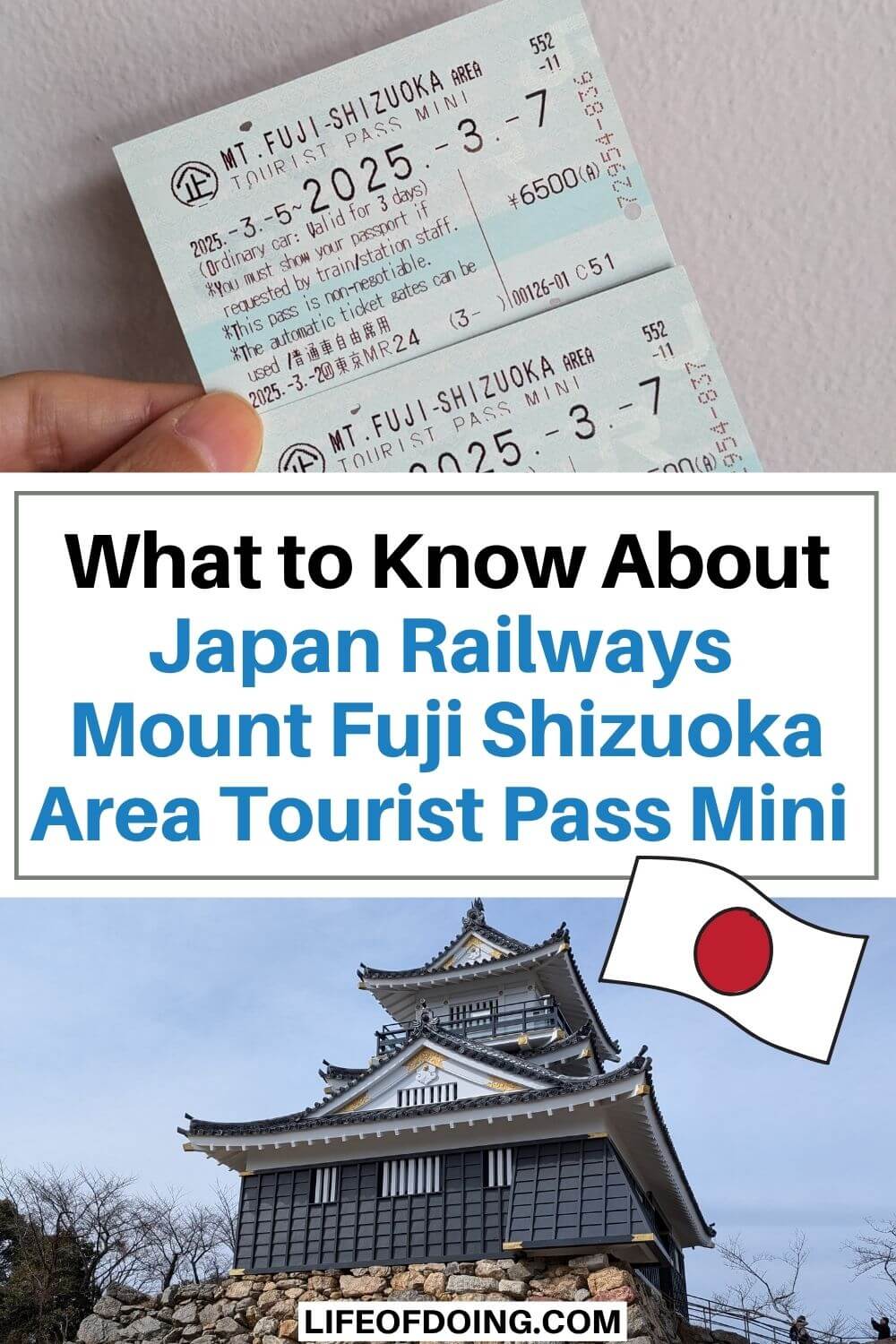Planning a trip to Japan’s Shizuoka Prefecture and Mount Fuji area and need a train pass?
Justin and I researched the various Japan Railways (JR) regional train pass options and found the perfect solution – the JR Mount Fuji Shizuoka Area Tourist Pass Mini.
This 3-day pass is the only regional train pass for the area and is available for international tourists.
Many travelers like yourself seek the opportunity to visit as many places as possible. This train pass allows you to easily visit destinations such as Hamamatsu, the Izu Peninsula, Fujinomiya, and more.
We recommend it for first time or seasonal travelers with a short trip through the Shizuoka area. We stayed in Shizuoka’s Shimizu for 6 nights and used this pass for 3 days. The pass was so convenient to use! For the other days, we used our IC ICOCA transportation card.
We’ll share our experience about using the JR Shizuoka Area Tourist Pass Mini, such as the pros and cons of using it, what is included, and where we went. This post will help you decide whether you need it for your next trip.
*Disclaimer: This post contains affiliate links. If you click on them and make a purchase, we receive a small commission. There is no additional cost to you. Appreciate the support.
Quick Pros/Cons of JR Mt. Fuji Shizuoka Area Tourist Pass
Don’t have time to read the post? Here is a quick snapshot of the top reasons and things to consider about the train pass.
Pros
- Super easy and convenient to use.
- The pass includes trains, buses, and even a ferry ride to Mount Fuji and Shizuoka Prefecture.
- Save money on transportation.
Cons
- You must create an itinerary of places to visit ahead of time to maximize the pass.
- Shinkansen (high-speed bullet trains) cannot be used with the pass.
- This pass is only available for 3 consecutive days.
Benefits of the Pass (Pros)
Explore new places in Shizuoka Prefecture.
This pass allows you to visit many places in the Shizuoka area, such as Atami, Gotemba, Izu, Fuji Kawaguchiko, Fujinomiya, Shizuoka, Hamamatsu, and Toyohashi. You may stop at any of the JR stations in the area.
Since Shizuoka Prefecture is an expansive area, you’ll need to figure out where to visit in the 3 days.
Here are some options that we recommend:
- Seeing Mount Fuji: We recommend Fujinomiya, Gotemba, or Shimizu for beautiful views of Mount Fuji.
- If you want to eat delicious grilled eel (unagi in Japanese), then head to Hamamatsu. There are many delicious unagi restaurants right outside of Hamamatsu Station.
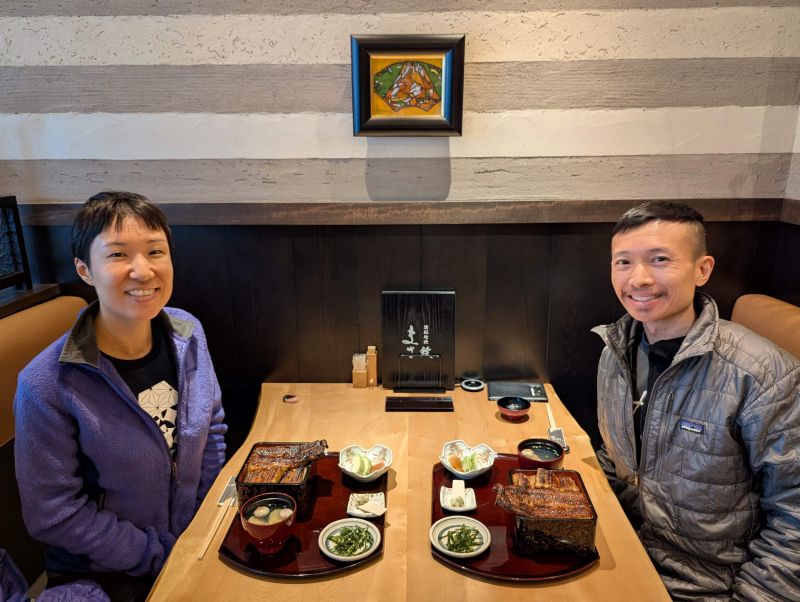
Justin and I love the unagi (grilled eel) in Hamamatsu!
- Visiting a quieter area: Many areas of Shizuoka Prefecture are less crowded and more peaceful. Izu Peninsula has gorgeous ocean and nature views.
You have access to JR trains, railways, buses, and a cruise with the pass.
Trains: You have unlimited access to JR local, limited express, express, and rapid trains in the specified area. These are for non-reserved seating only.
Here are examples of the JR lines you can take:
- Atami and Toyohashi Station on the Tokaido Main Line
- Numazu to Matsuda on Gotemba Line
- Fuji to Shimobe Onsen on Minobu Line
Izuhakone Railway: If you’re in Izu Peninsula area, you have access to the Izuhakone Railway between Mishima to Shuzenji Station.
Bus: You have access to the following routes:
- Fujikyuko Bus: Gotemba Station – Mt. Fuji Station, Shin-Fuji Station
- Tokai Bus: Mishima Station – Yamanaka Castle ruins / Numazu Station – Numazu Minato Shinsenkan / Shuzenji Station – Shuzenji Onsen / Shuzenji Station – Toi Port
- Izuhakone Bus: Numazu station – Numazu Port / Izunagaoka Station – IZU-MITO Sea Paradise / Shuzenji Station – Shuzenji Onsen
- Shizutetsu Bus: Shimizu Ekimae – Miho Marine Science Museum of TOKAI University
- Entetsu Bus: Hamamatsu Station – Nakatajima Shako / Hamamatsu Station – Kanzanji Onsen (Hamanako Garden Park)
Port Cruise: Lastly, you can take the Shimizu Port Cruise from Shimizu Port – Toi Port / Hinode – Hinode. Click here for more information.
What We Did: We used mostly the trains. We also took the Entetsu bus near Hamamatsu Station towards Hamamatsu Flower Park. We departed the bus near the Hamamatsu Castle area.
The pass is reasonably priced.
The 3 day pass costs 6,500 yen for adults and 3,250 yen for children (6 to 11 years).
To break even with the pass, adults need to spend 2,167 yen per day (children need 1,083 yen per day) on transportation.
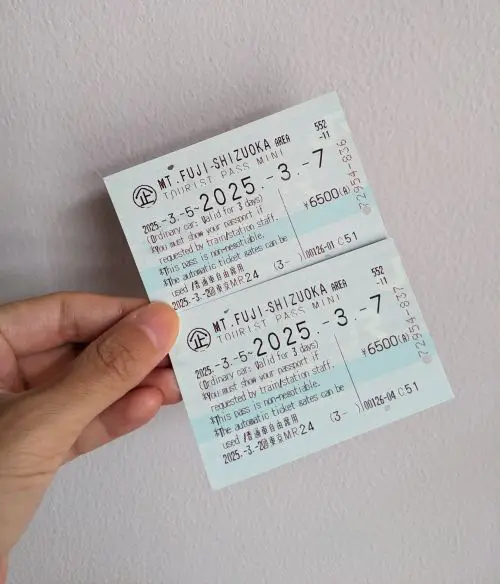
These are the JR Mt Fuji Shizuoka Area Tourist Pass Mini train passes that Justin and I used to travel around Fuji and Shizuoka
TIP: To maximize your schedule, plan where to go and the nearest JR station. Use the JR West Timetable and Route Finder to calculate the cost between the starting and ending stations. You can also find the train schedule. Afterward, calculate if the pass is worth it.
It is possible to ride 2,167 yen per day. The cost of the rides adds up!
Here are examples of the rides that we did and the cost:
- Shimizu to Fujinomiya Station – 30 minute limited express train. Cost: 1,350 yen one way
- Shimizu to Iwata Station – 1 hour 16 minute on local train. Cost: 1,340 yen one way
- Hamamatsu to Yaizu Station – 1 hour on local train. Cost: 1,170 yen one way
- Higashi Shizuoka to Kakegawa Station – 50 minutes on local train. Cost: 990 yen one way
Final Verdict: At the end of our trip, we calculated that we spent over 9,200 yen for 1 adult on the train and bus travels. The pass was 6,500 yen so we saved 2,700 yen by using the pass. Hooray for saving money!
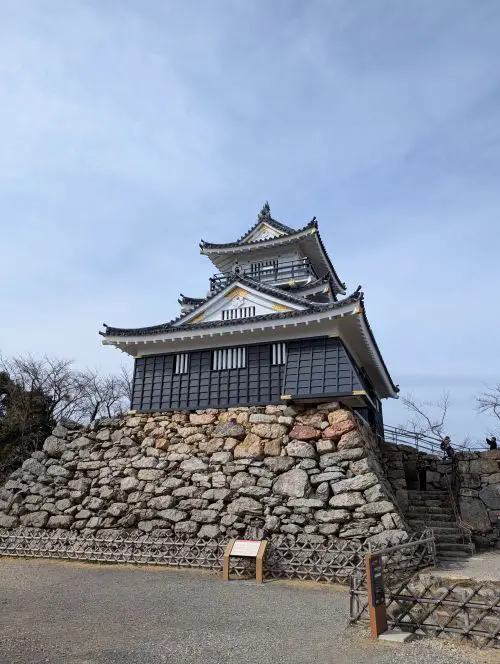
Hamamatsu Castle is one of the top attractions to visit in Hamamatsu
Save time with the pass.
Buying tickets with cash can take precious time, especially since trains arrive on time or have limited frequency. You need to look at the sign to figure out the cost between two stations and then buy the ticket.
With this pass, you just need to insert it into the turnstile and continue with your journey. It’s very easy to use.
Things to Consider About the Pass (Cons)
Calculate if the pass is worth the price.
For those who like to plan trips, this will be an important factor in determining if the pass is worth it.
We recommend creating a schedule of where to go. Then, you’ll need to look up the cost between the departure and arrival JR stations using this website. Afterward, calculate the total train cost and compare it with the pass.
For travelers who prefer to take their travels day by day or want flexibility, this pass will not be worth it. It’ll be better to buy individual train tickets or use an IC card (Suica, Pasmo, ICOCA) to enter and leave the station.
You’ll need to get to Shizuoka Prefecture first before activating the pass.
If you’re coming from Tokyo, Nagoya, or any other place, you’ll need to figure out a way to get to the Shizuoka area. Whether it’s by bus, plane, or train, you’ll need to pay out of pocket from your starting location to your destination in Shizuoka Prefecture. Then, you can activate the Mini Mount Fuji Shizuoka Pass from Shizuoka Prefecture.
Here are the places to exchange your physical voucher to the pass:
- Tokyo Station – Central Ticket Office or JR Tokai Tours
- Shinagawa Station
- Shin-Yokahama Station
- Nagoya Station
- Kyoto Station
- Shin-Osaka Station
What did we do?
We exchanged our physical pass at Tokyo Station’s JR Tokai Tours. We tried to use the Central Ticket Office but there was miscommunication or lack of understanding between us and the assistant managing the line. We did this right after I finished Tokyo Marathon.
Then we went to Shinjuku Expressway Bus at Shinjuku Station to make a reservation for the next day’s bus ride from Shinjuku to go to Shimizu Station. The ride was 3300 yen per person. Unfortunately, on the day of departure, the bus was canceled due to the snow on the highway.
So, we took the local JR trains from Shinjuku to Shimizu Station. We used Google Maps to map our trip. It took a total of 3 hours with transfers and waiting. We needed to transfer at 2 stations.
We traveled from Shinjuku to Totsuka Station in 38 minutes. Then we went from Totsuka to Atami Station in 1 hour 13 minutes. Lastly, we went from Atami to Shimizu Station in 1 hour 2 minutes.
Overall, the train cost was slightly cheaper than the bus by 200 yen.
We activated the Fuji Shizuoka Area Tourist JR Pass from Shimizu Station.
If you prefer to use JR trains only and to have the trains fully covered, then do not buy this pass. It’s recommended to get the JR All Japan Pass as you can have multi-day (7, 14, or 21 days) and a wider area of coverage. But check if the pass value is worth it! Click here to learn more about the JR All Japan Pass.
The pass does not cover Shinkansens (high-speed bullet trains).
If you want to use any Shinkansens, such as from Shizuoka to Hamamatsu on the Tokaido Shinkansen, you’ll need to pay out of pocket.
Many of the trains are local lines, so it will take longer to travel through the region.
You’ll need to factor in extra travel time on the local trains as they are slower. For example, traveling from Shimizu to Hamamatsu Station takes 1.5 hours one-way on the local CA Tokaido Line.
The limited express and rapid trains will get you to your destination faster but not as fast as the Shinkansen. They’re also limited so you’ll need to check the train schedule.
Consider these factors when planning your trip.
TIP: Use Google Maps to find the train schedule and estimated cost of the ride (It’s not always accurate compared to using the JR West Timetable). If you use Google Maps app, you can filter your results by “Best route, Fewer transfers, and Lowest cost.” The lowest cost will often show the local trains that will be acceptable for the pass.
This pass is valid for 3 consecutive days.
Unfortunately, you cannot take any breaks between days. For example, if you start the 3 day pass on May 1, then you have till 11:59pm May 3 to use the pass.
If you do not like the restriction, then you should not buy the pass. You can use an IC transportation card or buy tickets for the daily travels.
Cost
Adults: 6,500 yen
Children (6 to 11 years): 3,250 yen
Where to Buy the Pass
Buy the pass directly from the JR Pass website or an approved third-party vendor, such as Klook
We always buy our JR passes on Klook. We recommend them for your Japan rail travel passes and local attractions. They send the train physical vouchers to our Vietnam apartment within a few days after ordering.
How to Get Your Pass
Step 1: Buy the pass online and receive a physical voucher in the mail. You can buy on the JR Pass website or from a third-party vendor, such as Klook. We bought this exact pass on Klook.
Step 2: Redeem your voucher at a designated JR ticket exchange office. Each person receiving the pass needs to show a passport.
Step 3: Receive a light green train ticket with the start and end date and insert it at the turnstiles. Do not lose the ticket.
Where We Traveled With the Pass
We had 3 days to use the pass, so we went to as many places as possible.
We stayed in Shizuoka’s Shimizu area and departed from Shimizu Station for day trips.
After the pass was over, we used our ICOCA IC transportation card to take the local trains for shorter distances. Justin ran Shizuoka Marathon so he used his IC card to travel from Shimizu to Shizuoka Station to go to the start line.
Day 1: Travel from Shimizu to Fujinomiya Station. We spent the day in Fujinomiya. Returned to Shimizu for an overnight stay.
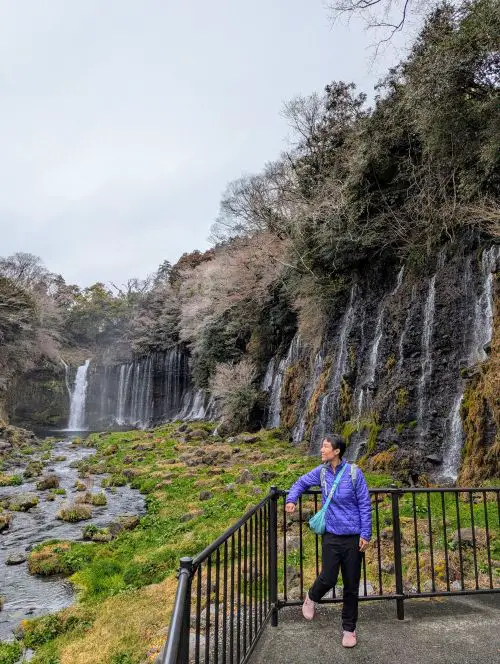
Shiraito Waterfall is a beautiful spot to visit in Fujinomiya
Day 2: Travel from Shimizu to Hamamatsu Station. Along the way, we also stopped by Iwata and Yaizu Station to pick up manhole cards at the nearby Information Centers. We spent the day in Hamamatsu and returned to Shimizu for our overnight stay.
Day 3: Travel from Shimizu to Kakegawa, Kanaya, and Hamamatsu Station. We originally wanted to take the ferry ride from Shimizu to Toi port, but the port was closed for maintenance. So, we went to the Kakegawa Castle, Shizuoka Tea Museum, and had lunch at Hamamatsu Station. We returned to our hotel in Shimizu.
Final Thoughts
We think the 3 days Mount Fuji Shizuoka Area Tourist Pass Mini is a fantastic way to explore Shizuoka area in a few days, especially for first time visitors. We recommend the pass and checking out places such as Shimizu Fish Market, Hamamatsu, and Fujinomiya.
Shizuoka area deserves more than 3 days, so we hope that you get a chance to return. Next time, we would like to visit Izu Peninsula with the pass.
If you have any questions about this pass, please ask a question in the comment section below.
Check out our other tourist train passes that we’ve written about:
Like this post? Save it to your Japan Travels Pinterest Board.

